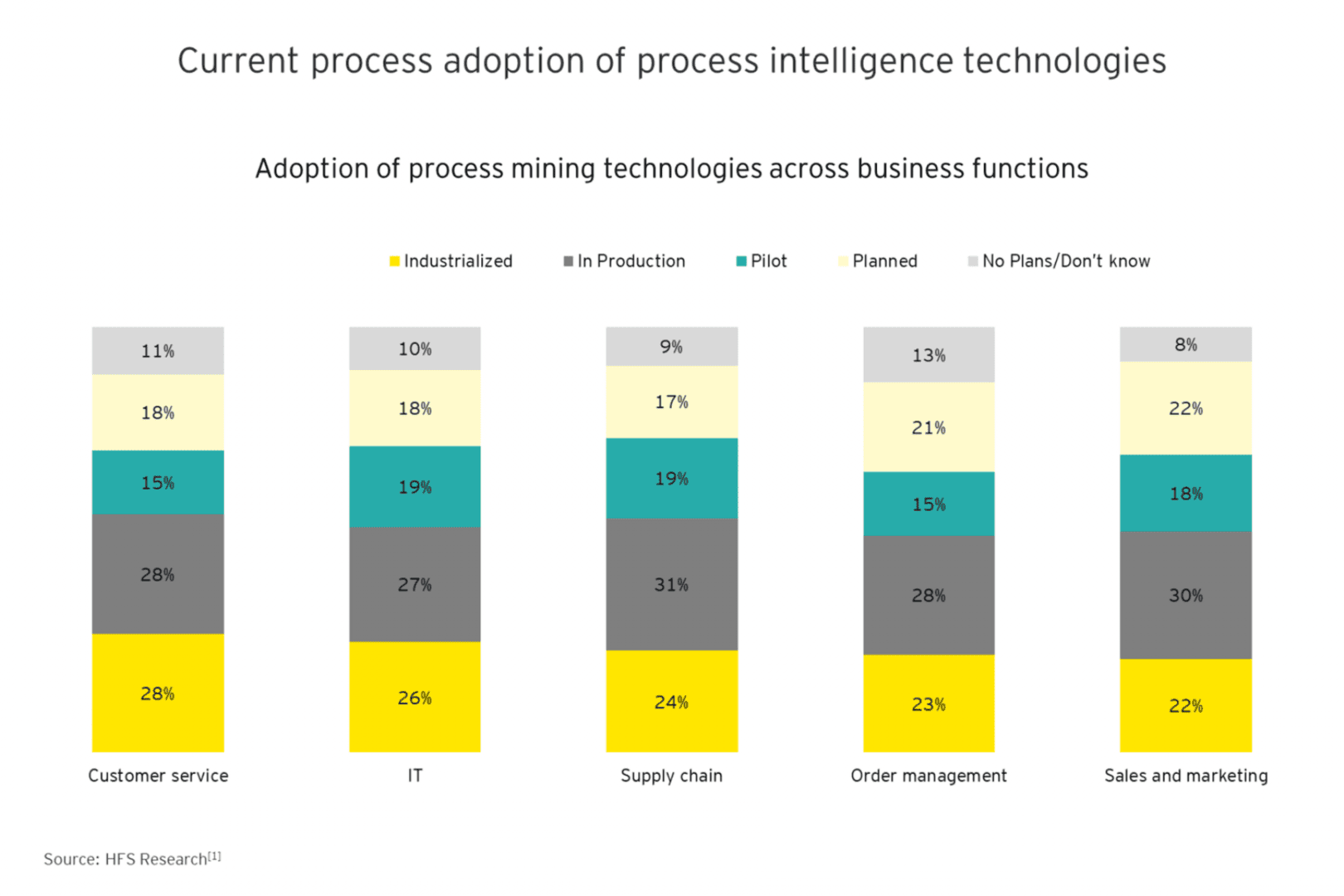EY refers to the global organization, and may refer to one or more, of the member firms of Ernst & Young Global Limited, each of which is a separate legal entity. Ernst & Young Global Limited, a UK company limited by guarantee, does not provide services to clients.

Process mining helps unlock business value across functions such as customer service, IT, supply chain, and sales and marketing.
In brief
- Process mining, with its wide-ranging applications across business functions, has the potential to unlock organization-wide efficiency and productivity.
- By initiating strategic implementations in specific areas and subsequently expanding to other functions, organizations can revolutionize their day-to-day operations and drive end-to end business transformation.
Processes serve as the foundation of every business operation, and the quality of these processes directly impacts the value an organization can deliver. In the modern age, unlocking the potential of process mining is paramount for understanding, optimizing, and continuously improving these critical processes. Throughout the series 'Driving organizational performance improvement through the lens of process mining,' we have delved into process mining as a concept, provided an industry overview, discussed its capabilities, and identified strategic approaches and critical success factors for a successful program. In this article, we aim to provide insights into the most successful functions and areas to target for realizing substantial value.
Common areas for process mining
As organizations embark on their process mining journey, they often grapple with a fundamental question: which area should be considered while initiating the program? Process mining can be implemented across various organizational functions; however, the key to success lies in selecting a pilot use case with clear objectives. Starting with a pilot that yields tangible business benefits allows organizations to demonstrate the potential and build confidence across other functions, thereby fostering a wide-scale adoption.
The adoption of process mining varies across organizations and business functions, but a clear trend of its adoption is emerging and steadily gaining momentum. Several organizations have already introduced process mining within specific business areas. Prominent among these areas are Customer Service, Information Technology (IT), Supply Chain, Order Management, and Sales and Marketing.

Within Customer Service, process mining can be used to evaluate case management systems, seeking avenues to reduce resolution times, enhance self-service capabilities, analyze rejection and cancellation rates to improve overall customer satisfaction. In the area of Information Technology, process mining contributes to identify first-touch resolution, incorrect queue assignments with, multi-hops, measure the mean time to resolve (MTTR), and track asset compliance. When it comes to Supply Chain, process mining proves invaluable for streamlining productivity and efficiency. It provides insights to identify top-performing suppliers, closely track delivery schedules and contractual obligations, and monitor maverick buying. Furthermore, it helps to track non-PO based invoices, avoid duplicate payments, avail potential discounts, and improve overall touchless processing. Order Management can greatly benefit from process mining by improving first-time right orders, monitoring, and enhancing On-Time In-Full delivery (OTIF), tracking rejected orders, and overseeing the overall cycle time. Lastly, Sales and Marketing can leverage process mining techniques to analyze lead management, predict lead conversion, and utilize AI/ ML capabilities for demand forecasting, making each step in the sales and marketing process more efficient and accountable.
A successful process mining implementation case
A global oil and gas major recently established their process mining Centre of Excellence (CoE), with a focus on the Procure-to-Pay (P2P) function. Following a successful implementation, the program was extended to other functions, including customer service, order management, accounts receivables, and core operations. This strategic adoption led to the identification of multiple improvement opportunities and tangible business value. Some notable examples include:
- Proactively identifying duplicate invoices to avoid multiple payments.
- Monitoring and resolving orders on credit block, delivery block, and billing block.
- Prioritizing and addressing customer service tickets which are due or overdue.
- Identifying inefficiencies in cash application automation and improving automation percentages.
- Reducing overdue safety-critical work by enhancing material availability and minimizing stockouts.
Reshaping business operations and beyond
In the modern world of business operations, efficiency, optimization, and innovation are the cornerstones of success. Process mining has emerged as a powerful tool to improve efficiency, optimize processes, and drive innovation. It has become the gateway for business transformation aiming to revolutionize business operations, serve customers, run financial processes, operate supply chain, and much more.
Summary
Process mining can deliver immense organizational value when implemented across multiple business functions.
How EY can help
-
Discover how EY's intelligent automation team can help your business implement a holistic view of automation, process & service improvement with our intelligent automation consulting services.
Read more -
Discover how EY's analytics consulting services can help you apply analytics throughout your organization to help grow, protect and optimize your business.
Read more -
Discover how EY's technology transformation team can help your business fully align technology to your overall purpose and business objectives.
Read more
Related articles
How skills-first transformation can unlock a new approach to talent potential
Discover the power of a Skills-First Transformation in unlocking untapped talent potential. Explore innovative approaches to unleash your workforce's capabilities.
Why GenAI is a top agenda for Indian CEOs: CEO outlook survey 2023
The latest EY report finds that CEOs recognize the potential of AI but are encountering significant challenges in developing AI strategies. Read more.
Pharma and healthcare for India@100: a century of change on the horizon
Unleashing India's pharma potential: Innovation, integration, and equitable healthcare access for a thriving future.






